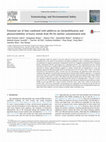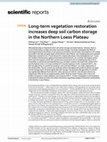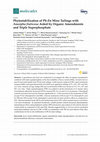Papers by Tanveer Ali Sial
FUUAST Journal of Biology, Jun 25, 2021

Ecotoxicology and Environmental Safety, 2017
This explorative study was aimed to assess the efficiency of lime alone and in combined with addi... more This explorative study was aimed to assess the efficiency of lime alone and in combined with additives to immobilize Pb, Cd, Cu and Zn in soil and reduce their phytoavailability for plant. A greenhouse pot experiment was performed by using low and heavily contaminated top soils viz. Tongguan contaminated (TG-C); Fengxian heavily contaminated (FX-HC) and Fengxian low contaminated (FX-LC). The contaminated soils were treated with lime (L) alone and in combined with Ca-bentonite (CB), Tobacco biochar (TB) and Zeolite (Z) at 1% and cultivated by Chinese cabbage (Brassica campestris L). Results revealed that all amendments (p < 0.05) significantly reduced the DTPA-extractable Pb 97.33, Cd 68.06 and Cu 91.11% with L+TB, L+CB, L+Z in FX-LC soil and Zn 87.12% respectively, with L+CB into TG-C soil. Consequently, the application of lime alone and in combined with additives were drastically decreased the dry biomass yield of Brassica campestris L. as compared with control. Thus, these feasible amendments potentially maximum reduced the uptake by plant shoots upto Pb 53.47 and Zn 67.93% with L+Z and L+TB in FX-LC soil, while Cd 68.58 and Cu 60.29% with L+TB, L+CB in TG-C soil but Cu uptake in plant shoot was observed 27.26% and 30.17% amended with L+TB and L+Z in FX-HC and FX-LC soils. On the other hand, these amendments were effectively reduced the potentially toxic metals (PTMs) in roots upto Pb77.77% L alone in FX-HC, Cd 96.76% with L+TB in TG-C, while, Cu 66.70 and Zn 60.18% with L+Z in FX-LC. Meanwhile, all amendments were responsible for increasing soil pH and CEC but decreased soils EC level. Based on this result, these feasible soil amendments were recommended for long termstudy under field condition to see the response of another hyper accumulator crop.
Fresenius Environmental Bulletin, 2018

Major area under banana cultivation in Pakistan consists of a single cultivar "Dwarf Cavendi... more Major area under banana cultivation in Pakistan consists of a single cultivar "Dwarf Cavendish" called "Basrai". Quality of banana relies on the available nutrients in soil. Under poor fertility and organic matter scenario coupled with high requirement of banana, this study evaluated the combined effect of organic (farm manure and composted pressmud) and inorganic (NPK) sources of nutrients on nutrient composition of locally grown banana. Application of full NPK (500-250500 kg ha) increased the fruit P (0.08-0.12%), K (0.77-1.50%) and Zn (1.74-2.17 mg kg) over full N and the respective values further increased to 0.14 and 0.22%, 2.28 and 1.79% and 2.42 and 2.21% with farm manure and composted pressmud additions. Moreover, there was a non-significant increase in N and significant one in Cu and Fe. There was no additional benefit of 1.25 NP. In fact, the higher rates i.e. full NPK and 1.25 NP reduced the micronutrient contents of fruit due to dilution effect. Howev...

Journal of Plant Ecology, 2021
Afforestation is helpful to improve soil functions and increase soil organic carbon (SOC) sequest... more Afforestation is helpful to improve soil functions and increase soil organic carbon (SOC) sequestration in semiarid deserts. However, the fine-scale (around a single plant) spatial distribution of SOC and its liable organic carbon (LOC) fractions after afforestation in semiarid deserts are poorly understood. Pinus sylvestris and Salix psammophila afforested on shifting sandy land (Sland) were selected to quantify fine-scale (at 20, 80, 150, and 240 cm away from the trees) spatial distribution of SOC and its LOC fractions in the southeast edge of Mu Us Desert, China. The results showed that the afforested S. psammophila and P. sylvestris significantly increased SOC, total nitrogen (TN), dissolved organic carbon (DOC), microbial biomass carbon (MBC) and readily oxidized organic carbon (ROOC). At 20 cm distance, SOC storage of P. sylvestris was 27.21% higher than S. psammophila in 0–100 cm soil layers, and SOC storage of S. psammophila at 80 cm and 150 cm distances were 5.50% and 5.66%...

In the present study, 120 out of 150 barley double haploid lines, obtained by crossing „Steptoe‟ ... more In the present study, 120 out of 150 barley double haploid lines, obtained by crossing „Steptoe‟ x „Morex‟, were screened for the 4 traits including plant height, peduncle length, spike length and grains plant, during three crop years in the area of Northwestern China. Quantitative trait loci (QTL) mapping was performed from the available genotype datasets using the 4.1Version of QTL IciMapping. In total, 15 QTLs were mapped on six linkage groups (1H, 2H, 3H, 4H, 5H and 7H) which explained 5.42% to 47.27% phenotypic variation. Four QTLs were recognized in three years for plant height including two QTLs of major impact, one on chromosome 2H in 2014-15 and 2015-16, and the other was detected only in 2016-17 on chromosome 4. While for spike length, four QTLs were found. Six QTLs were identified underlying the trait peduncle length with three major QTLs, two on chromosome 2H in 2015-16 and 2016-17, and one on 3H in 2014-15 and 2015-16. One major QTL for the trait grains plant was identi...

Journal of Soils and Sediments
Vegetation restoration is an effective measure for improving the function of soil ecosystems and ... more Vegetation restoration is an effective measure for improving the function of soil ecosystems and promoting the biogeochemical cycling of carbon (C), total nitrogen (TN) and total phosphorus (TP). Here, we aimed to quantify the fine-scale (pedon scale) spatial distribution of soil C, N, P and soil physical–chemical properties in the Mu Us Desert ecosystems. We systematically evaluated the effects of A. ordosica on fine-scale (pedon scale) spatial distribution of C, TN, TP, soil-available nutrients, and liable organic carbon (LOC) and their stoichiometric characteristics in the semiarid Mu Us Desert in the 0–100-cm soil profiles at various distances from the plant. The results demonstrated that soil organic carbon (SOC), TN and LOC were decreased with increasing distance from the plant and soil depth. SOC stocks at 20 cm were 16.98% higher than those at 120 cm from the plant. SOC stocks at 20, 60 and 120 cm from the plant were increased by 71.62%, 58.14% and 46.72% compared with shifting sandy land (Sland), respectively. Microbial biomass carbon (MBC) and readily oxidised organic carbon (ROOC) were significantly affected by different soil layers and distances and their interaction (p < 0.05), whereas dissolved organic carbon (DOC) was affected by the soil layers. TN and soil-available nutrients in the surface layer and at closer distances to the plant were higher than those in the sublayer and Sland. The ratio of C:N:P was generally decreased with different distances from the plant and different soil layers. The ratios of soil C:N, C:P and N:P were significantly different at different soil layers, whereas the ratios of soil C:P and N:P were significantly different at different distances from the plant (p < 0.05). Soil C:P ratio was positively correlated with soil C:N and N:P ratios (p < 0.001). N and P contents in leaves were higher than those in roots, branches and litter, but C contents in leaves were lower than those in other plant tissues and litter (p < 0.01). N:P ratio in leaves (13.94) showed that there was a shortage of N and P in the Mu Us Desert ecosystems. We concluded that A. ordosica could enhance the accumulation of SOC, LOC and N on a fine scale and improve mineral-nutrient availability in semiarid deserts and, as a result, the function of soil ecosystems could be improved. Moreover, the limitation of N and P can be alleviated by adding additional N and P.

Scientific Reports
Afforestation plays an important role in soil carbon storage and water balance. However, there is... more Afforestation plays an important role in soil carbon storage and water balance. However, there is a lack of information on deep soil carbon and water storage. The study investigates the effect of returning farmland to the forest on soil carbon accumulation and soil water consumption in 20-m deep soil profile in the hilly and gully region of the Chinese Loess Plateau. Four sampling sites were selected: Platycladus orientalis (Linn.) Franco forest (PO: oriental arborvitae), Pinus tabulaeformis Carr. Forest (PT: southern Chinese pine), apple orchard (AO) and farmland (FL, as a control). Soil organic carbon (SOC) and soil inorganic carbon (SIC) content were measured in 50-cm sampling intervals of 20-m soil profiles, as well as the associated factors (e.g. soil water content). The mean SOC content of PT was the highest in the 1–5 m layer and that of FL was the lowest (p 0.05), respectively, in the whole profile. The SIC content was relatively uniform throughout the profile at all land-u...
Pakistan Journal of Botany

Journal of Environmental Management
A field experiment was carried out to evaluate the effects of different biochars on grain yield a... more A field experiment was carried out to evaluate the effects of different biochars on grain yield and phytoavailability and uptake of macro- and micro-nutrients by rice and wheat grown in a paddy soil in a rotation. Soil was treated with i) maize raw (un-washed) biochar (MRB), ii) maize water-washed biochar (MWB), iii) wheat raw biochar (WRB) or iv) wheat water-washed biochar (WWB) and untreated soil was used as control (CF). Inorganic fertilizers were applied to all soils while biochar treated soils received 20 ton ha-1 of designated biochar before rice cultivation in rice-wheat rotation. The WRB significantly (P < 0.05) increased rice grain yield and straw by up to 49%, compared to the CF. Biochar addition, particularly WRB, significantly increased the availability of N, P, K and their content in the grain (26-37%) and straw (22-37%) of rice and wheat. Also, the availability and grain content of Fe, Mn, Zn, and Cu increased significantly after biochar addition, particularly after the WRB, due to WRB water dissolved C acting as a carrier for micronutrients in soil and plant. However, the water-washing process altered biochar properties, particularly the water extractable C, which decreased its efficiency. Both wheat- and maize-derived biochars, particularly the WRB, are recommended to improve nutrients availability and to improve grain yield in the rice-wheat rotation agro-ecosystem. These results shed light on the importance of crop straw transformation into an important source for soil C and nutrients necessary for sustainable management of wheat-rice agro-ecosystem. However, with the current and future alternative energy demands, the decision on using crop biomass for soil conservation or for bioenergy becomes a challenge reliant on regulatory and policy frameworks.

Molecules, Apr 1, 2020
A greenhouse pot trial was conducted to investigate the effect of organic amendments combined wit... more A greenhouse pot trial was conducted to investigate the effect of organic amendments combined with triple superphosphate on the bioavailability of heavy metals (HMs), Amorpha fruticosa growth and metal uptake from Pb-Zn mine tailings. Cattle manure compost (CMC), spent mushroom compost (SMC) and agricultural field soil (AFS) were applied to tailings at 5%, 10%, 20% and 30% w/w ratio, whereas sewage sludge (SS) and wood biochar (WB) were mixed at 2.5%, 5%, 10% and 20% w/w ratio. Triple superphosphate (TSP) was added to all the treatments at 4:1 (molar ratio). Amendments efficiently decreased DTPA-extracted Pb, Zn, Cd and Cu in treatments. Chlorophyll contents and shoot and root dry biomass significantly (p < 0.05) increased in the treatments of CMC (except T4 for chlorophyll b) and SMC, whereas treatments of SS (except T1 for chlorophyll a and b), WB and AFS (except T4 for chlorophyll a and b) did not show positive effects as compared to CK1. Bioconcentration factor (BCF) and translocation factor (TF) values in plant tissues were below 1 for most treatments. In amended treatments, soluble protein content increased, phenylalanine ammonialyase (PAL) and polyphenol oxidase (PPO) decreased, and catalase (CAT) activity showed varied results as compared to CK1 and CK2. Results suggested that A. fruticosa can be a potential metal phytostabilizer and use of CMC or SMC in combination with TSP are more effective than other combinations for the in situ stabilization of Pb-Zn mine tailings.

Waste Management
The environmentally safe disposal of the large quantity of orange peels waste produced each day c... more The environmentally safe disposal of the large quantity of orange peels waste produced each day causes economic and environmental problems, which after conversion into biochar via pyrolysis technique might be used as an effective soil amendment. In this study, a 90-day incubation experiment was conducted to investigate the effects of orange peel waste and waste-derived biochar amendments on greenhouse gas emissions (GHG), soil biochemical properties, and soil enzyme activities. There were five treatments with different amendment levels: control without an amendment (Control), orange waste 1% (W1), orange waste 2% (W2), orange waste biochar 1% (B1), and orange waste biochar 2% (B2). The results showed that, compared with control, the amendments decreased cumulative N2O emissions by 59.2% (B2), 45.2% (B1), 20.6% (W2) and 10.2% (W1), respectively; and increased cumulative CH4 emissions by 81.7% (W1), 84.4% (W2), 75.8% (B1) and 74.9% (B2), respectively. Cumulative CO2 emissions decreased for the B1 (29.3%) and B2 (43.5%) over the waste treatments. While soil pH, SOC, nitrate nitrogen (NO3--N) and enzyme activities (urease and catalase) were significantly increased with the passage of time from the biochar amendments, ammonium nitrogen (NH4+-N) and invertase activities did not show this trend with time. Our study suggests that orange peel waste conversion to biochar should be a viable alternate method of disposal since land application resulted in reduced GHG and improvements in soil fertility.

Journal of Basic & Applied Sciences
Sustainable crop management relies on the combined use of organic and inorganic sources of nutrie... more Sustainable crop management relies on the combined use of organic and inorganic sources of nutrients. The experiment was laid out in a split plot design with manures (control, farmyard manure, sesbania and cluster bean) as main split and mineral fertilizer rates (control, 40-30, 60-45, 80-60, 90-70 and 120-90 kg N-P 2 O 5 ha -1 ) as sub-split. The manures significantly influenced shoot dry weight, N, P and K uptake and soil properties. Conversely, the rates of mineral fertilizers did not have any effect on soil properties, however, significantly enhanced the shoot dry weight and N, P and K uptake. The combined use of manures and mineral fertilizers had a significant effect on shoot P uptake. Farmyard manure was the best manure amendment with 13% reduction in bulk density and 51% increase in organic matter content over control. Incorporation of farmyard manure increased the shoot dry weight and N, P and K uptake, respectively by 8, 14, 11 and 8% over control. Among rates of mineral fertilizers, recommended rate of mineral fertilizer (120-90 kg N-P 2 O 5 ha -1 ) was the best treatment with corresponding increase of 26, 81, 56 and 55% in shoot dry weight, N, P and K uptake over control. Integration of farmyard manure with recommended rate of mineral fertilizer enhanced shoot P uptake by 17% as compared to solo application of mineral fertilizers. Through this study, it was concluded that farmyard manure at 6 tons ha -1 coupled with mineral fertilizer rate of 120-90 kg N-P 2 O 5 ha -1 was the best source for sustainable soil health and wheat production.

Process Safety and Environmental Protection
Abstract The huge quantity of banana peels waste from juice industries and fruit markets every da... more Abstract The huge quantity of banana peels waste from juice industries and fruit markets every day is indicating a potential bio-resource which is major task for environment safety. It can be converted into useful material instead of being dumped in landfill site, and reduce the environment and economic problems. In this study, we compared the influence of banana peels waste and its biochar on greenhouse gas emissions, soil enzyme activities and chemical properties of soil at 90 days incubation period. There were five treatments of amendments: no amendment (Control), banana peel 1% (P1), banana peel 2% (P2), biochar 1% (B1) and biochar 2% (B2). Results indicated that biochar amendment significantly decreased cumulative nitrous oxide (N2O) emissions (37.1%–54.8%), whereas banana peels amendment did not significantly decrease cumulative N2O emissions (1.3%–5.3%) as compared to control. Biochar application decreased the soil ammonium nitrogen (NH4+-N) and nitrate nitrogen (NO3−-N) with an increasing rate. Cumulative carbon dioxide (CO2) emissions for B1 and B2 treatments decreased 20.0% and 24.0% in comparison to the banana peel amendment, respectively. Cumulative methane (CH4) emissions were higher in peel waste than biochar amendment. Soil enzyme activities (urease, invertase and alkaline phosphatase) were significantly increased by biochar amendment. In contrast, banana peel amendment increased soil ammonium nitrogen, soil microbial biomass carbon (MBC) and microbial biomass nitrogen (MBN), β-glucosidase and urease activities. We concluded that banana peels waste conversion to biochar should be an alternate method of disposal since its application resulted in the reduced greenhouse gas emissions and improved the soil biochemical properties. This biochar should be further tested under field conditions to confirm the potential for mitigating of GHG emissions and soil biochemical properties.











Uploads
Papers by Tanveer Ali Sial